CHI22 Trip Report
A blogpost by Elahi Hossain
As a second-year PhD student who began in the midst of a pandemic, attending CHI2022 in-person was THE academic event I was most looking forward to. I had only previously attended CHI virtually and had felt the experience fell short of expectations; with it mainly being a lonely and overloading stream of link surfing between various video recordings and chatrooms. I therefore had high hopes for CHI2022. Arriving at the airport length venue amidst a morning tropical storm to pick up my access card, I was impressed by the scale (although I heard this year was far smaller in capacity) and breadth of research and perspectives, which was not evident through the previous virtual conference. I found the most fruitful interactions actually occurred between paper/journal sessions, and in the main hall during poster sessions, where researchers mingled amongst food and drinks.

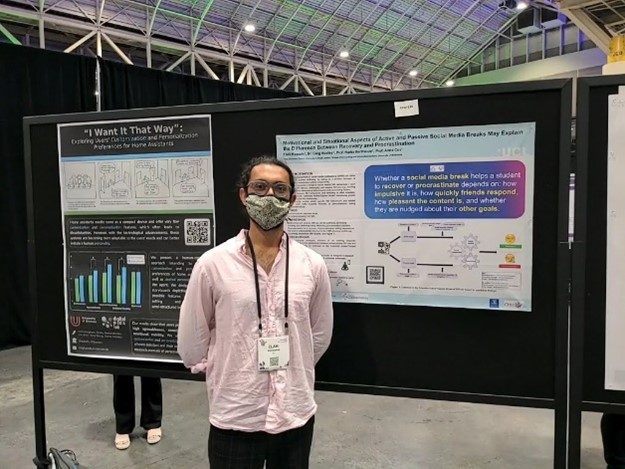
Methods for design
Whilst at CHI22 I was exposed to a range of new approaches to design through papers and poster sessions, something which I have not been exposed to as much in the PhD. This included: 1) First-person soma-based design e.g. Focusing method (Höök et al., 2021; Núñez-Pacheco & Loke, 2022; Ståhl et al., 2021);
2) User-oriented co-design methods/frameworks e.g. participatory-design (Dahl & Sharma, 2022; Kornfield et al., 2022, 2022), Stanfords d.school five-stage model (Aagaard et al., 2022), heuristics e.g. for person-centred digital coaching interventions (Ryan et al., 2022), and research through design – how to balance top-down theory with bottom-up user data (Gaver, 2012);
3) Speculative design methods e.g. pre-visualizations (Ivanov et al., 2022);
4) Repertoires (actions to increase nonhuman participation in the design process) (Oogjes & Wakkary, 2022); and
5) Niche design maxims e.g. Gricean Maxims for chatbot conversational behaviour (Setlur & Tory, 2022).
These new methods of design have left me utterly inspired. I am now rethinking how I can go about designing a new digital tool as part of my PhD – opting to more seriously consider a ‘bottom-up’ approach to the design that prioritises the user’s expertise, rather than taking a solely ‘top-down’ theoretical approach. I envision this occurring through multiple design workshops with users to both ideate and evaluate potential design solutions (Steen et al., 2008).
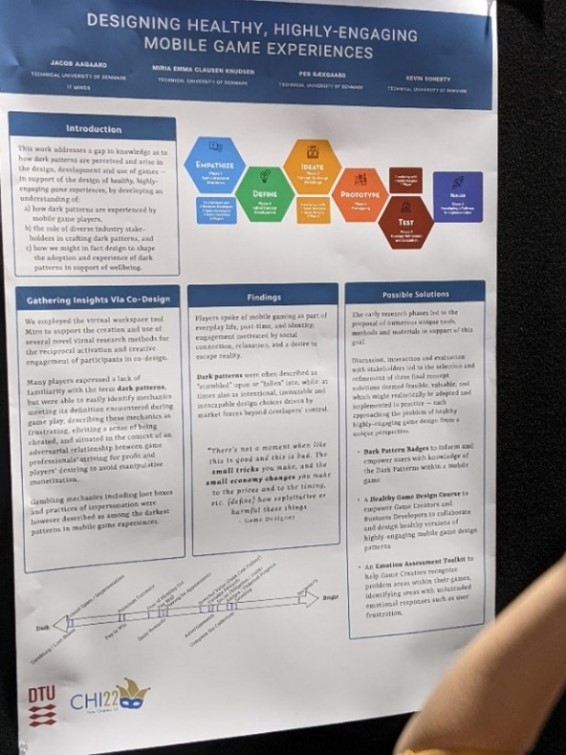
Digital emotion regulation / self-regulation
Because my PhD has a focus on emotion regulation, I also looked for other research on the same topic. I was exposed to a range of interventions that integrated an emotion regulation/self-regulation lens which ranged from tangible devices (Bou Ghanem & Yoon, 2022; Daudén Roquet et al., 2022) to digital tools for emotion-regulation (Chen et al., 2022; Howe et al., 2022) and self-regulation of digital technology in general (Xu et al., 2022).
Sense of agency and Mindfulness
These concepts came up a lot across CHI22 and seem to be heavily linked with my findings that the automaticity/autonomy of digital behaviour is strongly linked to wellbeing.
A sense of agency/control may be an important aspect of user experience (Bergström et al., 2022). I saw digital interventions increase users’ sense of agency during social media use (Zhang et al., 2022), investigations on how mindfulness practices are best incorporated into digital technologies (Li & Leshed, 2022), and the features that detract from these concepts e.g. dark patterns (Aagaard et al., 2022; Monge Roffarello & De Russis, 2022); often these concepts were situated in digital distraction:
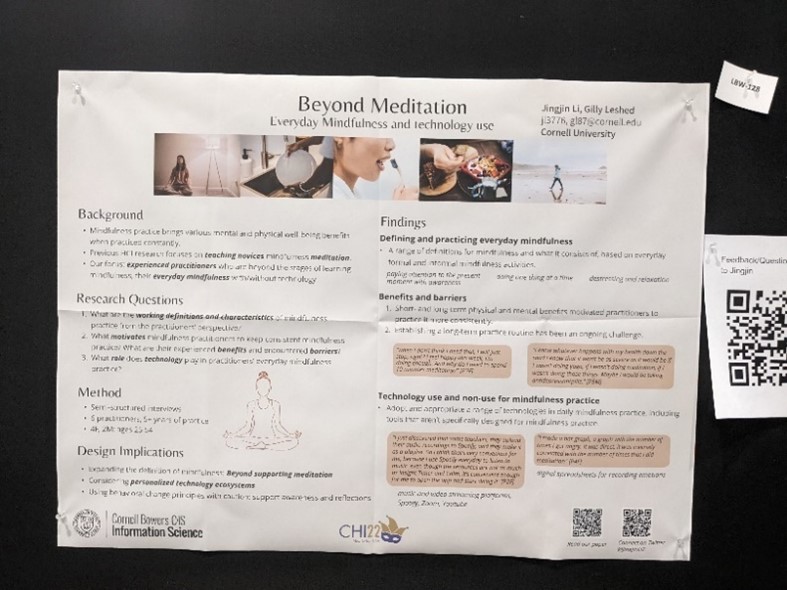
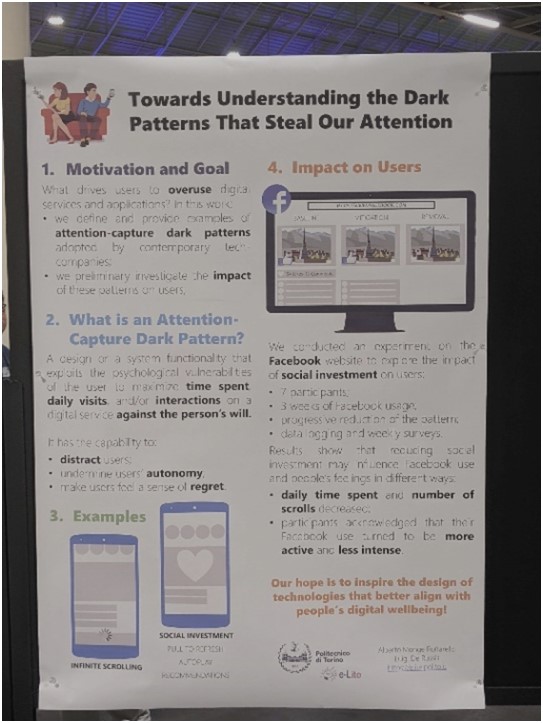
Moving from a PhD into industry
I’m still on the fence as to the direction I want to head after the PhD: academia or industry. Whilst at CHI22 I attended a talk by Google about moving from a PhD into an industry role. The talk was given by two recent PhD students now working as UX researchers at Google. It covered definitions: what is a UX researcher? What life is like within industry versus academia, and what skills acquired from a PhD are desired in industry.
These are the bullet points I noted down on my phone whilst listening:
| – context is key – iterative product design – translate research experiences: technical skills communication skills: v important to be open to different audiences, time and project management – Cross functional collaboration empathy is key: – articulate research design rationale: strength and limitations – cv: make clear research design, impact, stakeholders |
References
Aagaard, J., Knudsen, M. E. C., Bækgaard, P., & Doherty, K. (2022). A Game of Dark Patterns: Designing Healthy, Highly-Engaging Mobile Games. CHI Conference on Human Factors in Computing Systems Extended Abstracts, 1–8. https://doi.org/10.1145/3491101.3519837
Bergström, J., Knibbe, J., Pohl, H., & Hornbæk, K. (2022). Sense of Agency and User Experience: Is There a Link? ACM Transactions on Computer-Human Interaction, 29(4), 28:1-28:22. https://doi.org/10.1145/3490493
Bou Ghanem, M., & Yoon, J. (2022). Variapsody: Creating Three Interactive Music Listening Experiences that Use Diversified Positive Emotion Regulation Strategies to Promote Subjective Well-being. CHI Conference on Human Factors in Computing Systems Extended Abstracts, 1–7. https://doi.org/10.1145/3491101.3519743
Chen, S.-C., Chang, Y.-H., Huang, J.-H., Hsu, C.-W., Lin, C.-H., & Kuo, P.-Y. (Patricia). (2022). Exploring the Effect of Emotion Awareness Intervention on Reducing FoMO. CHI Conference on Human Factors in Computing Systems Extended Abstracts, 1–7. https://doi.org/10.1145/3491101.3519839
Dahl, Y., & Sharma, K. (2022). Six Facets of Facilitation: Participatory Design Facilitators’ Perspectives on Their Role and Its Realization. CHI Conference on Human Factors in Computing Systems, 1–14. https://doi.org/10.1145/3491102.3502013
Daudén Roquet, C., Theofanopoulou, N., Freeman, J. L., Schleider, J., Gross, J. J., Davis, K., Townsend, E., & Slovak, P. (2022). Exploring Situated & Embodied Support for Youth’s Mental Health: Design Opportunities for Interactive Tangible Device. CHI Conference on Human Factors in Computing Systems, 1–16. https://doi.org/10.1145/3491102.3502135
Gaver, W. (2012). What should we expect from research through design? Proceedings of the SIGCHI Conference on Human Factors in Computing Systems, 937–946. https://doi.org/10.1145/2207676.2208538
Höök, K., Benford, S., Tennent, P., Tsaknaki, V., Alfaras, M., Avila, J. M., Li, C., Marshall, J., Roquet, C. D., Sanches, P., Ståhl, A., Umair, M., Windlin, C., & Zhou, F. (2021). Unpacking Non-Dualistic Design: The Soma Design Case. ACM Transactions on Computer-Human Interaction, 28(6), 40:1-40:36. https://doi.org/10.1145/3462448
Howe, E., Suh, J., Bin Morshed, M., McDuff, D., Rowan, K., Hernandez, J., Abdin, M. I., Ramos, G., Tran, T., & Czerwinski, M. P. (2022). Design of Digital Workplace Stress-Reduction Intervention Systems: Effects of Intervention Type and Timing. CHI Conference on Human Factors in Computing Systems, 1–16. https://doi.org/10.1145/3491102.3502027
Ivanov, A., Au Yeung, T., Blair, K., Danyluk, K., Freeman, G., Friedel, M., Hull, C., Hung, M. Y.-S., Pratte, S., & Willett, W. (2022). One Week in the Future: Previs Design Futuring for HCI Research. CHI Conference on Human Factors in Computing Systems, 1–15. https://doi.org/10.1145/3491102.3517584
Kornfield, R., Meyerhoff, J., Studd, H., Bhattacharjee, A., Williams, J. J., Reddy, M., & Mohr, D. C. (2022). Meeting Users Where They Are: User-centered Design of an Automated Text Messaging Tool to Support the Mental Health of Young Adults. CHI Conference on Human Factors in Computing Systems, 1–16. https://doi.org/10.1145/3491102.3502046
Li, J., & Leshed, G. (2022). Beyond Meditation: Everyday Mindfulness and Technology Use. CHI Conference on Human Factors in Computing Systems Extended Abstracts, 1–6. https://doi.org/10.1145/3491101.3519820
Monge Roffarello, A., & De Russis, L. (2022). Towards Understanding the Dark Patterns That Steal Our Attention. CHI Conference on Human Factors in Computing Systems Extended Abstracts, 1–7. https://doi.org/10.1145/3491101.3519829
Núñez-Pacheco, C., & Loke, L. (2022). Focusing for Interaction Design: An Introspective Somatic Method. CHI Conference on Human Factors in Computing Systems, 1–18. https://doi.org/10.1145/3491102.3501978
Oogjes, D., & Wakkary, R. (2022). Weaving Stories: Toward Repertoires for Designing Things. CHI Conference on Human Factors in Computing Systems, 1–21. https://doi.org/10.1145/3491102.3501901
Ryan, K., Dockray, S., & Linehan, C. (2022). Understanding How eHealth Coaches Tailor Support For Weight Loss: Towards the Design of Person-Centered Coaching Systems. CHI Conference on Human Factors in Computing Systems, 1–16. https://doi.org/10.1145/3491102.3501864
Setlur, V., & Tory, M. (2022). How do you Converse with an Analytical Chatbot? Revisiting Gricean Maxims for Designing Analytical Conversational Behavior. CHI Conference on Human Factors in Computing Systems, 1–17. https://doi.org/10.1145/3491102.3501972
Ståhl, A., Tsaknaki, V., & Balaam, M. (2021). Validity and Rigour in Soma Design-Sketching with the Soma. ACM Transactions on Computer-Human Interaction, 28(6), 38:1-38:36. https://doi.org/10.1145/3470132
Steen, M., de Boer, J., Kuiper-Hoyng, L., & Visser, F. S. (2008). Co-design: Practices, challenges and lessons learned. Proceedings of the 10th International Conference on Human Computer Interaction with Mobile Devices and Services – MobileHCI ’08, 561. https://doi.org/10.1145/1409240.1409350
Xu, X., Zou, T., Xiao, H., Li, Y., Wang, R., Yuan, T., Wang, Y., Shi, Y., Mankoff, J., & Dey, A. K. (2022). TypeOut: Leveraging Just-in-Time Self-Affirmation for Smartphone Overuse Reduction. CHI Conference on Human Factors in Computing Systems, 1–17. https://doi.org/10.1145/3491102.3517476
Zhang, M. R., Lukoff, K., Rao, R., Baughan, A., & Hiniker, A. (2022). Monitoring Screen Time or Redesigning It? Two Approaches to Supporting Intentional Social Media Use. CHI Conference on Human Factors in Computing Systems, 1–19. https://doi.org/10.1145/3491102.3517722
Crowdworkers’ temporal flexibility is being traded for the convenience of requesters through 19 ‘invisible mechanisms’ employed by crowdworking platforms
This year at CHI2022 we will be presenting our work that explores how the design of crowdworking platforms impacts the amount of temporal flexibility experienced by workers on the platforms. You can see the Late Breaking Work paper here
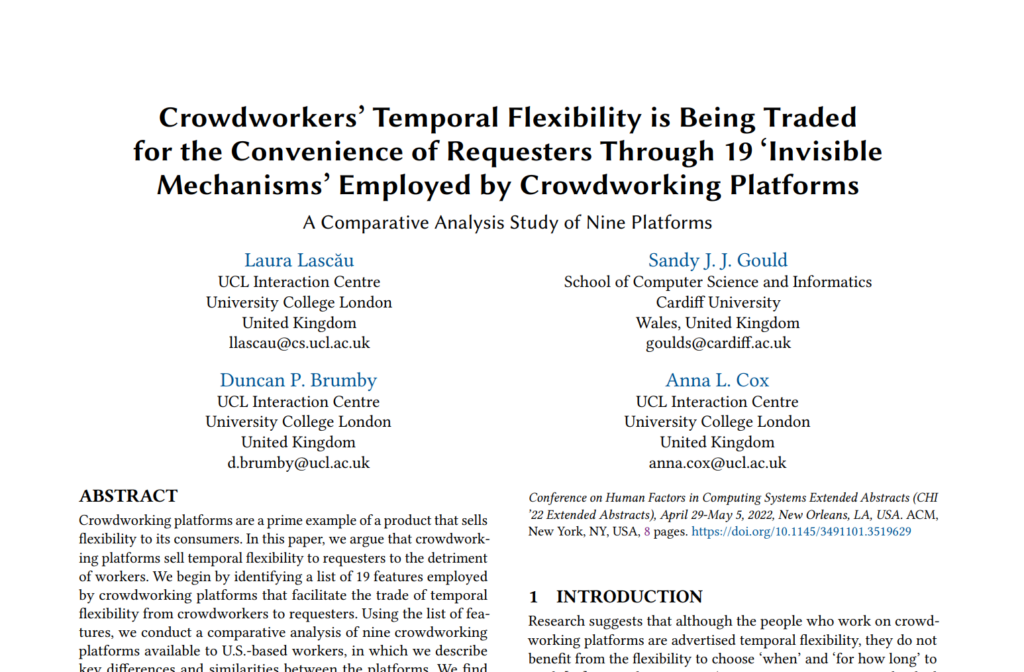
We find that:
- Crowdworking platforms strongly favour features that promote requesters’ temporal flexibility over workers’ by limiting the predictability of workers’ working hours and restricting paid time. The results of our study show the different ways in which the values held by the customers of the technology (i.e., requesters), instead of the values of those impacted by the technology (i.e., workers), can be embodied consciously or unconsciously by technology
- Using the temporal precarity scores that we calculated, we identified which platforms available to U.S.-based workers employed the highest number of features that facilitated the trade of flexibility from workers to requesters, consequently increasing workers’ temporal precarity. These are useful for two reasons. First, the people working on crowdworking platforms can benefit from having increased awareness about the exploitative mechanisms of crowdworking platforms, although they might have little power to change them. Second, requesters can also benefit from reflecting on the power asymmetries perpetuated by crowdworking platforms when choosing which platforms to use in their work.
You can watch a 3 minute video summary of the paper here:
A Workshop & 2 SIGs accepted for CHI 2022
The eWorkResearch group will be involved in three academic community building events at CHI 2022.
- A workshop titled The Future of Emotion in Human-Computer Interaction
2. A special interest group (SIG) meeting titled Moving from BCI to Personal Cognitive Informatics
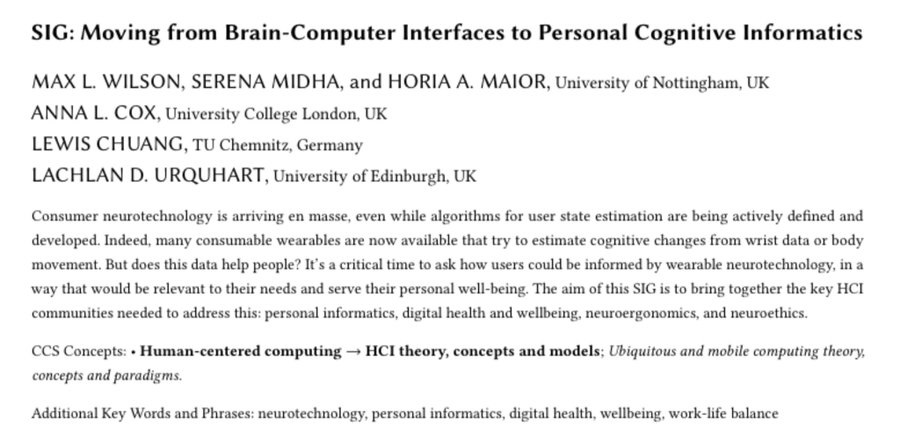
3. A special interest group meeting titled Human-Computer Interaction and the Future of Work. Find out more about this at the CHIWORK website
Email Charter
We can help reverse the problems caused by email overload. Be part of the solution.
1. Respect recipients’ time
Make your email easy to read: use these plain English tips to save others time AND make your communication more effective.
2. Short is not rude
It’s ok to be brief. Don’t take brevity personally and know that others won’t. Wordy responses take longer to read. People will scan it and are less likely to read it all; key details can be easily missed.
3. Celebrate clarity
Subject line: write a short subject line that clearly gives the topic.
Opening line: make it the basic reason for writing.
4. Slash CCs
Only CC someone who really needs this message. Don’t thoughtlessly ‘Reply all’: choose individual recipients.
5. Tighten the thread
If you need to include the email trail showing the context, cut what’s not relevant. If it’s long, summarise or make a phone call instead.
6. Reduce attachments
Don’t use images like logos in your signature – they’ll be attached and I’ll try to open it in case it’s something relevant.
7. Should we expect an instant response?
Don’t feel you need to give an instant response, and don’t expect to get one. Skype or the telephone are your tools if something is urgent.
8. Disconnect sometimes
Can you calendar half-days for email-free working? And you should be having email-free evenings, weekends, holidays. Have an ‘auto-response’ that makes it clear you’re not checking.
9. Reference this charter
Spread the word and help change email culture. Reference this charter in your email footer.
This charter was adapted from emailcharter.org which as of 18 Jan 2019 seems to have died. 🙁 This text was copied from the University of Kent’s website who have kept the email charter alive.
There is more information about the email charter at theTEDBlog
COVID Ward
A blogpost by Emma Holliday, student on MSc HCI 2019-2021

Getting into the video games industry was originally my inspiration for studying Computer Science. As I learned about the often toxic work environments (and sexism) in the gaming industry, I decided to leave this dream behind and went into software development instead. That’s why I’m so amazed and thrilled to have actually designed and built my own game and, even better, to have won an award for it.
Click here to play the game! Spoilers below!
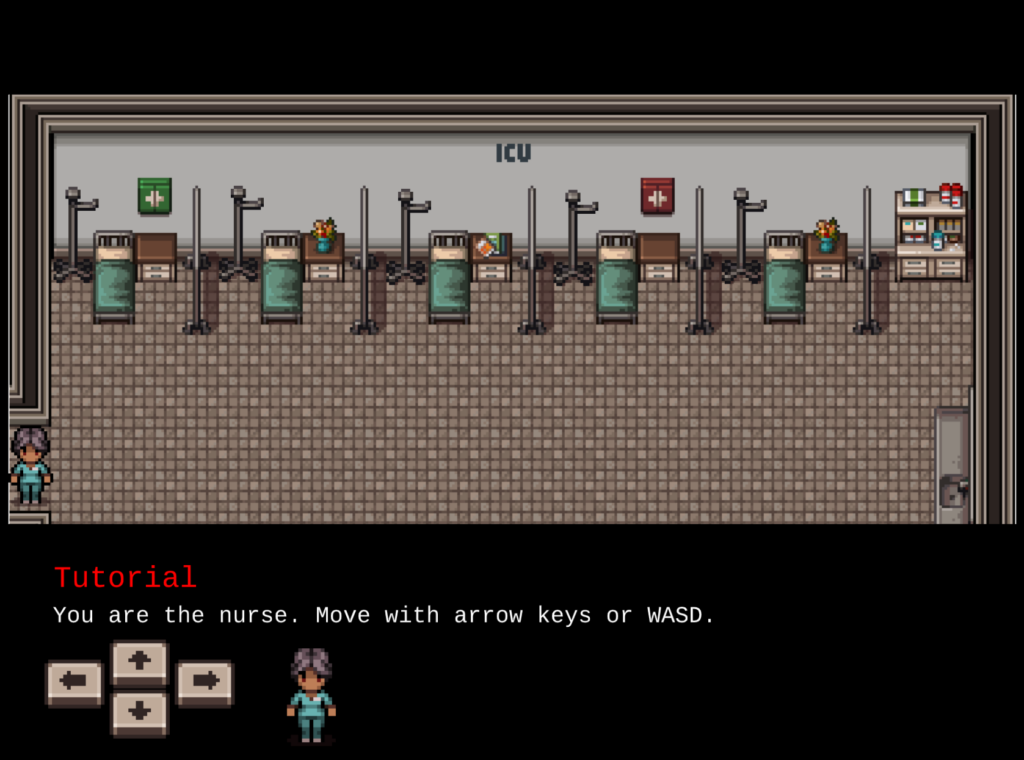
The game itself was built as part of my coursework for the Serious and Persuasive Games module (led by Prof Anna Cox) on the Human-Computer Interaction course at UCL. (Even though I had somewhat given up on a career in the gaming industry, I still really loved games and would take any excuse to learn about them and play them.) Something that really stood out to me during the lectures was the concept of the “Magic Circle”, an idea that games exist within set boundaries that are separate to the real world. This means that different rules apply within game (e.g. violence is allowed), actions in the game don’t have consequences in the real world, and actions in the real world don’t apply to the game. I immediately challenged this – I’m sure we’ve all had that gaming session that left friendships a little sour even after the game had finished, learnt something new or even strengthened our relationships. I personally believe, particularly with narrative-based games, it is very unlikely to not leave some lasting impression in the real world long after the game has been played. As such, I designed a game that would exploit breaking the “Magic Circle” by including people’s real-world actions into gameplay. My hopes were that, by breaking the “Magic Circle” upfront, this would weaken the boundaries between the game and the real world, encouraging players to take experiences from the game back into real life.
My time studying this module was during the COVID-19 pandemic which also provided a lot of inspiration, largely because it was inescapable and incredibly topical. Other games which we studied during the module were also influential, particularly those on blame culture in nursing (such as Nurse’s Dilemma and Patient Panic). All of this culminated in my game, COVID Ward, where players take on the role of a nurse working in the intensive care unit during the COVID-19 pandemic. The gameplay is quite simple, players use arrow keys to control the nurse and spacebar to administer aid to patients in the ward. Patient health deteriorates over time and they will eventually die if their health becomes too low while fully healed patients are able to leave the ward. The game plays out as levels representing 12 hour shifts, so time is limited and the nurse character can only do so much in a day. In between levels is where the “Magic Circle” is broken; the player is asked a question relating to their real-world actions during the pandemic and their answer affects the number of patients admitted to the ward during the next level. For example, the question may ask if the player always wore a mask while on public transport. If the player answers “no”, there would be more patients in the ward the next day than if they had answered “yes”. Through this, players see the their actions directly associated with the effects on other people and healthcare staff.
The game was refined iteratively thanks to playtesting with my friends, fellow students, and staff on the Serious and Persuasive Games course. Finally, a user study was completed to test if the game had the desired effects of making people feel more responsible for their actions, encouraging them to follow COVID-19 safety guidance more closely and increasing empathy for nursing staff. Though it was a small scale study, initial results were very positive and suggested that the game had achieved its goal in terms of attitude change. Qualitative responses from participants repeatedly mentioned the use of their real world actions and suggested it was both engaging and encouraged them to reflect more deeply on their actions. As such, breaking the “Magic Circle” is a promising technique for persuasive games which warrants further research.
In terms of development, the game was built using Game Salad (a no-code game authoring tool). Though I’m familiar with code, (and there were times I wished I was using code!) GameSalad did provide a really quick way to get started and put ideas together without too much learning overhead. Having since tried to pick up Unity, I can say Game Salad is definitely a lot quicker to get your ideas into something working, which is crucial for iterative development. Game Salad also made it very easy to publish my game so that others could play it online, which helped enormously when getting feedback and conducting the user study as there was no installation or downloads required.
In an early version of the game, everything was represented by incredibly simple shapes and numbers. While I support the concept of primarily using the mechanic to deliver the message, as demonstrated remarkably in Brenda Romero’s games, I felt my game would benefit from graphics and sound effects to help immerse the player and reinforce the narrative that these were real people affected by their actions, encouraging stronger empathy. Given the short time frame (and that I am only one person who is not talented enough to do everything from scratch!) I was exceedingly grateful for assets created by other artists which allowed me to create something that was much more complete than I could have achieved on my own. I found the music by Bio_Unit on Free Music Archive and got sound effects from Kenney.nl (a fantastic source for several free assets!) I paid for some pixel-art assets from Malibu Darby through Humble Bundle which, very fortunately, had a game dev bundle just as I was building the game. I also dabbled in editing the pixel art myself to customise it to my game. If you’d like to give that a go, I recommend aseprite.
Overall, I was really happy with my game and the results of the user study. Prof. Anna Cox had suggested that the class submit their work to the CHI PLAY student game competition. Earlier in my time at UCL, Prof. Catherine Holloway had encouraged us to always try and share our work with the academic community and introduced me to Student Research Competitions. These are often held across different ACM conferences (such as SIGCHI, SIGACCESS, CHIPLAY) and felt much more approachable to me as the level of work expected was closer to what I had already done for my coursework. As such, I decided to go for it and submit my game and a paper detailing the user study to CHI PLAY 2021’s Student Game Design Competition. I didn’t really expect to win anything, but I was just happy to share my game in the hopes it might have a life beyond my university coursework grades.
So I was very excited when I heard back to find out my game had been accepted! It turns out, 8 of the 19 submissions were accepted to the conference as finalists. This did mean, however, that I had a bit more work to do! I updated my paper to respond to the reviewers’ comments, battled with the proper formatting and TAPS submission system (though the support staff are really helpful), and created a reaction video to be played at the conference. I’d be lying if I said it wasn’t stressful (largely because it fell right across the deadline for my final MSc dissertation!!) but it was definitely worth it to see my work presented at the conference and all the interest it generated. Even more so when I was announced as receiving an honourable mention for the competition! I also got to attend the entire conference – though you don’t have to be an author to do so – and joined lots of interesting talks and presentations across all aspects of games.
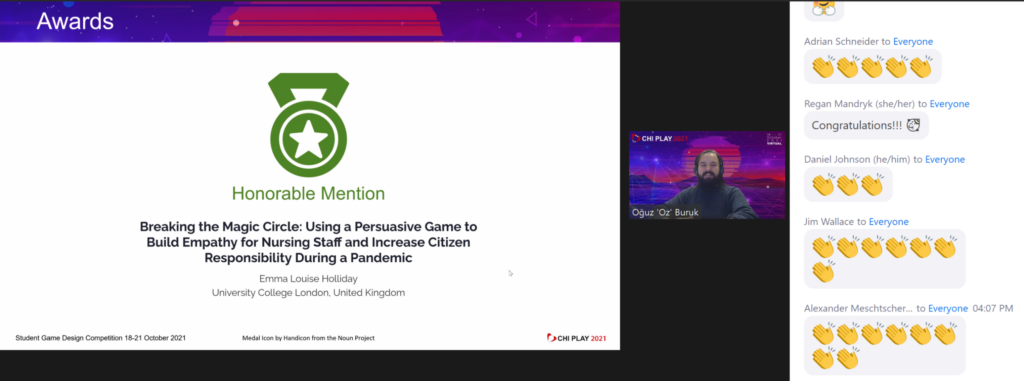
It was really rewarding finding myself back in the games industry, in a sense, but from a completely different direction than I had ever imagined and one that was much better suited to me and my passions. It was even more rewarding to know that I had contributed to it and that, maybe one day, my research will have an impact on the games I end up playing on my sofa.
Find out more about the competition and see the other entries
Every wondered how to get someone to reply to your email?
Me this week: why is this guy chasing me for a reply today when he only emailed me on Thursday?
Also me this week: how come that person I emailed on Wednesday last week STILL hasn’t replied?
We’ve all spent time hitting the refresh button on an inbox waiting for a reply to an email we’ve sent and wondering what’s holding things up. The truth is, people send urgent emails before others and if they think a reply to your email is not urgent and is going to take them ages to write, you might be waiting a really long time!

Our frustration waiting for others to reply to our emails led us to investigate which factors influence how quickly people respond to emails and whether there’s anything we can do as a sender to get them to choose to reply to us before answering someone else’s message!The results of our study of 45 people responding to 16,200 e-mails sent over a 3 week period show that when e-mail replies are not urgent, people wait to a later time to send replies rather than responding immediately. However, when they do respond they are more likely to tackle the messages that are easier to respond to (eg needing a short reply) and those that carry the greatest importance (eg when there’s something in it for the sender). In contrast, when presented with e-mails that need an urgent reply, people prioritize these and disregard factors such as length of reply.

Our results are important for all of us who use e-mail and want timely responses. Composing e-mails that clearly signal that an urgent response is needed is the best way to ensure that the receiver will deal with it promptly. If it’s not urgent, making clear that you just need a short response will mean your email gets replied to before others.
Anna L. Cox, Jon Bird, Duncan P. Brumby, Marta E. Cecchinato & Sandy J. J. Gould (2021) Prioritizing unread e-mails: people send urgent responses before important or short ones, Human–Computer Interaction, 36:5-6, 511-534, DOI: 10.1080/07370024.2020.1835481
How did people respond to the disruption to work caused by the pandemic?
Our paper “The new normals of work: a framework for understanding responses to disruptions created by new futures of work” has just come out in Human-Computer Interaction Journal.
Open access to the paper is available here: https://www.tandfonline.com/doi/full/10.1080/07370024.2021.1982391
In the paper, we explore how people adapted to work during the pandemic and how we might understand people’s response to disruption in the new future of work. We highlight a number of issues, tools and strategies that people used in their work to support them while working remotely. For example, virtual commutes, having dedicated space, new scheduling techniques or staying connected with colleagues through virtual chats and async chats
Exploring these with the Genuis and Bronstein model of “new normal” we show 3 kinds of responses:
- waiting to return to old normal,
- finding a new normal and
- anticipating a new future of work.
These new normals of work help us to understand how we can help workers going forward.

We’d like to thank our reviewers for their feedback and our participants for helping develop our work within eworklife.co.uk and a special shoutout to @DilishaBP whose work with the new normal model inspired this work 😀 You can find their paper on Finding a “New Normal” for Men Experiencing Fertility Issues here: dl.acm.org/doi/abs/10.114…
If you find this interesting you might also like our other papers on work during the pandemic:
- Disengaged From Planning During the Lockdown? An Interview Study in an Academic Setting Yoana Ahmetoglu; Duncan P. Brumby; Anna L. Cox (2021) IEEE Pervasive Computing
- Staying Active While Staying Home: The Use of Physical Activity Technologies During Life Disruptions Joseph W. Newbold, Anna Rudnicka and Anna Cox (2021) Frontiers in Digital Health
- Eworklife: Developing effective strategies for remote working during the COVID-19 pandemic A Rudnicka, JW Newbold, D Cook, ME Cecchinato, S Gould, AL Cox (2020) The New Future of Work Online Symposium
The first draft of this blogpost was written as a twitter thread by Joe Newbold and unrolled using ThreadReader
CHI 2021 – a blog post by Shiping Chen
When the Social Becomes Non-Human
Have you ever interacted with non-humans? A team of researchers from the University of Oslo and the SINTEF examined how young people perceive various types of social support provided by chatbots. Their results indicate that chatbots can be a daily source of social support for young people, helping them think about themselves more constructively, and stimulating self-disclosure without social judgment by offering a safe and anonymous space for conversation.
Read the research paper here: https://dl.acm.org/doi/10.1145/3411764.3445318
Young people are increasingly suffering from mental health issues, but they tend not to seek out professional help. Despite needing social support, young people often struggle to reach out to others. This problem has become more acute during the COVID-19 pandemic. Unexpected changes to professional and personal lives have placed a burden on people’s mental health. Pandemic-related restrictions such as lockdowns and social distancing have made it more difficult to receive in-person support from friends and professionals. As a result of all this, we now urgently need effective online tools that can provide people with the social support they need.
Chatbots, especially those designed for social and mental health support (social chatbots, or emotionally aware chatbots), can help meet these demands. As artificial agents, chatbots interact with users through natural language dialogue (text, speech, or both). Social chatbots, such as Replika, Woebot, and Mitusuku, imitate conversations with friends, partners, therapists, or family members to be humanlike, with the potential to perceive, integrate, understand, and express emotions.
Other online channels (e.g., Instagram, Facebook, online groups, and health forums, etc.) can also provide social support to young people, however they carry certain limitations such as the risk of receiving inaccurate guidance or the possibility of not receiving help from others despite reaching out.
The researchers conducted in-depth interviews with sixteen young people aging from 16-25 years old. They found that after using Woebot for two weeks, most participants reported that the chatbot provided appraisal support and informational support; around half of them received emotional support; and some received perceived instrumental support.
- Appraisal support: Support offered in the form of feedback, social comparison, and affirmation.
- Emotional support: Expressions of empathy, love, trust, and caring.
- Informational support: Advice, suggestions, and information given by the chatbot to help the user solve a problem.
- Instrumental support: Tangible aid, which is characterized by the provision of resources in offering help or assistance in a tangible and/or physical way, such as providing money or people.
So more specifically, what did the sixteen young people’s find was good about these chatbots? First of all, as a non-human agent, the conversational chatbot can make people feel like they are writing a diary entry or speaking in a way to themselves, thereby facilitating self-reflection, and making self-disclosure easier, safer, and more honest. Using chatbot for social and emotional support is also thought to be more reliable than talking to a human, as well as being a good choice for discussing worries that are more personal or private.
As artificial agents, chatbots can easily provide users with lots of relevant, immediate, and efficient information, without being constrained by time or space. This may be useful when our worries extend beyond the scope of our friends’ knowledge or expertise. Moreover, different sources of support can act collaboratively, as the chatbot Woebot was reported to motivate users to contact others for help as well as guiding people in their search for information, which indicates that a chatbot may have the potential to help solve practical problems.
However, despite the many positive comments from users, using current chatbots for social support is not a perfect solution. Current chatbots may have biases, or inadequate or failed responses, affecting the quality of the user experience. Psychologically, getting support from others makes some people feel ‘cared for and loved’, which is not the case when receiving response from a chatbot, as some may see chatbots as merely robots and not emotional. People who need chatbots as a source of support, may need time to develop relationships, become familiar with and develop trust towards chatbots. Through conversations about personal stories, user’s private data is collected and stored in chatbots. Ensuring users’ privacy and maintaining a relationship of trust is another challenge.
Indeed, chatbots provide us with a new way to get connected and supported besides the traditional human-human context. It could be further evaluated and studied in a larger sample and different user groups. This brings further questions about how chatbots for social support may influence the future of human communication. Imagine the future – when one day chatbots can provide social support like real people. What will be the human-human relationship at that time? When we have another place (chatbots) to talk about our distress or happiness, how will it affect our interpersonal relationships?
CHI 2021 – a blog post by Elahi Hossain
How AI is helping us connect in digital spaces

With the COVID-19 pandemic resulting in stringent social restrictions around the world, I was fascinated by how individuals (including myself) adapted to our newfound situation. Living in a new reality where I could not meet up with friends and family, I, like others, turned to social technologies to satiate my need for connection. However, with all other social affordance stripped away, I was left unsatisfied with the current capabilities of online socialising. Online messaging and video-calling did not seem to satisfy my social cravings. At times, it was dry, awkward, and overwhelming. It truly took a pandemic to realise the deficiencies of digital devices in emulating the deep, rich, exciting (and often messy) offline interactions we took for granted in our pre-pandemic life.
Therefore, as the CHI 2021 conference came around, I was excited to see what new research was being undertaken to make the online socialising experience more meaningful. As I scoured the programme, favouriting talks relating to online communication, social media, etc., I noticed that two studies incorporated artificial intelligence (AI) to help make online interactions more affect sensitive through ‘AI-mediated communication’. ‘Affect’ refers to the psychological common-denominator of our emotional lives, underpinning emotions, moods, feelings, etc. (Russell, 2003). So how were researchers leveraging AI to help make our online interactions more affective, and should they be?
The first study by Murali et al. (2021) titled: AffectiveSpotlight: Facilitating the Communication of Affective Responses from Audience Members during Online Presentations, developed and investigated the efficacy of a Microsoft Teams embedded affect-sensitive AI-bot (named AffectiveSpotlight). The study aimed to address the problem of limited audience-presenter interaction during online presentations by implementing AffectiveSpotlight which was able to capture and communicate the affective responses from the audience to the presenter. The bot would analyse emotive responses (valued by presenters) of each audience member in real-time and spotlight the most expressive to the presenter without labelling the emotion; allowing the presenter to interpret it themselves. The study found that usage of AffectiveSpotlight improved the presenter’s experience: making them feel more aware of their audience, speak for longer periods (implying reduced speaker anxiety), and also led to self-rating of their presentation quality that was closer to audience members responses. Whilst these were promising results, participants were solely from the tech sector, limiting the overall generalisability of findings to other social groups who also perform online presentations e.g., teacher-student interactions.
The second study by Liu et al. (2021) titled: Significant Otter: Understanding the Role of Biosignals in Communication, explored the usage of a smartwatch-based AI software (named Significant Otter) that analysed users bio-signals (heart rate) to generate a set of possible emotional states that the user could choose from and send to their romantic partner via animated otters. The qualitative study followed romantic couples for over a month to investigate the role of Significant Otter’s bio-signal sharing capability in communication. Couples reported that the ability to share bio-signals in this manner supported easier, authentic communication and nurtured a greater sense of social connection. These were exciting results; however, the paper did mention how some participants questioned themselves when the presented possible emotional states did not match what they felt internally. Also, other participants would blindly accept Significant Otters suggestions leading them to reflect less on their actual state.
These papers fascinated me; I had never thought that AI could help close the emotional gap between individuals in digital space, and how this helped to facilitate richer online interactions. Research into affect-sensitive AI is integral to the HCI field of affective computing. There have been past calls in this field to frame affect not as discrete units of information to be processed by a computer (affect as information), but as dynamic, socio-culturally embedded outcomes experienced through interaction (affect as interaction) (Boehner et al., 2005). It was interesting to see how the new technologies introduced in CHI 2021 were veering to the latter framing, where participants in Liu et al (2021 and Murali et al. (2021) were left free to interpret the emotions presented by the technologies and ascribe meaning themselves. It is exciting to see current affect-sensitive technologies taking this perspective as from a wider lens, it signals a shift from technologies being representational tools, to being participatory tools. I cannot wait to see what is in store next!

